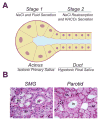Ca²⁺-dependent K⁺ channels in exocrine salivary glands
- PMID: 24559652
- PMCID: PMC4058408
- DOI: 10.1016/j.ceca.2014.01.005
Ca²⁺-dependent K⁺ channels in exocrine salivary glands
Abstract
In the last 15 years, remarkable progress has been realized in identifying the genes that encode the ion-transporting proteins involved in exocrine gland function, including salivary glands. Among these proteins, Ca(2+)-dependent K(+) channels take part in key functions including membrane potential regulation, fluid movement and K(+) secretion in exocrine glands. Two K(+) channels have been identified in exocrine salivary glands: (1) a Ca(2+)-activated K(+) channel of intermediate single channel conductance encoded by the KCNN4 gene, and (2) a voltage- and Ca(2+)-dependent K(+) channel of large single channel conductance encoded by the KCNMA1 gene. This review focuses on the physiological roles of Ca(2+)-dependent K(+) channels in exocrine salivary glands. We also discuss interesting recent findings on the regulation of Ca(2+)-dependent K(+) channels by protein-protein interactions that may significantly impact exocrine gland physiology.
Keywords: Ca(2+)-dependent K(+) channels; Epithelial ion transport; Exocrine glands; K(+) secretion.
Published by Elsevier Ltd.
Figures



References
-
- Amerongen AV, Veerman EC. Saliva--the defender of the oral cavity. Oral Dis. 2002;8:12–22. - PubMed
-
- Hay DI, Bowen WH. The functions of salivary proteins. In: Edgar WM, O’Mullane DM, editors. Saliva and oral health. 2. London, UK: British Dental Association; 1996.
-
- Humphrey SP, Williamson RT. A review of saliva: normal composition, flow, and function. J Prosthet Dent. 2001;85:162–169. - PubMed
-
- Mandel ID. Impact of saliva on dental caries. Compend Suppl. 1989:S476–481. - PubMed
-
- Sonies BC, Ship JA, Baum BJ. Relationship between saliva production and oropharyngeal swallow in healthy, different-aged adults. Dysphagia. 1989;4:85–89. - PubMed
Publication types
MeSH terms
Substances
Grants and funding
LinkOut - more resources
Full Text Sources
Other Literature Sources
Medical
Miscellaneous

